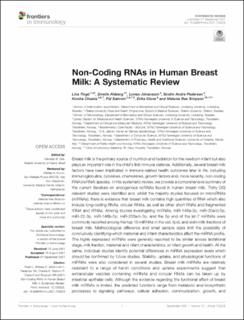| dc.description.abstract | Breast milk is the primary source of nutrition and hydration for the newborn infant but also plays an important role in the child’s first immune defense. Additionally, several breast milk factors have been implicated in immune-related health outcomes later in life, including immunoglobulins, cytokines, chemokines, growth factors and, more recently, non-coding RNA (ncRNA) species. In this systematic review, we provide a comprehensive summary of the current literature on endogenous ncRNAs found in human breast milk. Thirty (30) relevant studies were identified and, whilst the majority studies focused on microRNAs (miRNAs), there is evidence that breast milk contains high quantities of RNA which also include long-coding RNAs, circular RNAs, as well as other short RNAs and fragmented tRNA and rRNAs. Among studies investigating miRNAs, miR-148a-3p, miR-30a/d-5p, miR-22-3p, miR-146b-5p, miR-200a/c-3p, and the 5p end of the let-7 miRNAs were commonly reported among the top 10 miRNAs in the cell, lipid, and skim milk fractions of breast milk. Methodological difference and small sample sizes limit the possibility of conclusively identifying which maternal and infant characteristics affect the miRNA profile. The highly expressed miRNAs were generally reported to be similar across lactational stage, milk fraction, maternal and infant characteristics, or infant growth and health. All the same, individual studies identify potential differences in miRNA expression levels which should be confirmed by future studies. Stability, uptake, and physiological functions of miRNAs were also considered in several studies. Breast milk miRNAs are relatively resistant to a range of harsh conditions and uptake experiments suggest that extracellular vesicles containing miRNAs and circular RNAs can be taken up by intestinal epithelial cells. Although the evidence regarding the functional effect of breast milk miRNAs is limited, the predicted functions range from metabolic and biosynthetic processes to signaling pathways, cellular adhesion, communication, growth, and differentiation. Finally, this systematic review highlights some of the methodological challenges and knowledge gaps which can help direct future research in this field. In particular, it is important to further investigate the bioavailability of miRNAs in different milk fractions, and to characterize other ncRNAs which are largely unstudied. Systematic Review Registration: PROSPERO https://www.crd.york.ac.uk/prospero/display_record.php?RecordID=138989, identifier CRD42020138989. | en_US |

